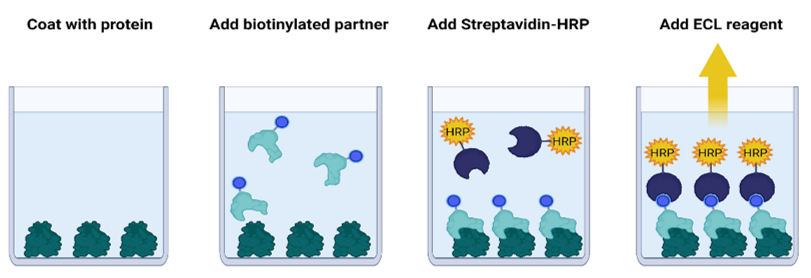CD155:TIGIT [Biotinylated] Inhibitor Screening Chemiluminescence Assay Kit
The CD155:TIGIT [Biotinylated] Inhibitor Screening Chemiluminescence Assay Kit is an ELISA-based assay designed for screening and profiling molecules that block the binding between CD155 (cluster of differentiation 55) and TIGIT (T-cell immunoreceptor with Ig and ITIM domains). This kit comes in a convenient 96-well format, with enough recombinant human biotin-labeled TIGIT (amino acids 22-141), CD155 (amino acids 27-343), streptavidin-labeled HRP, and assay buffer for 100 reactions.

Figure 1: Illustration of the mechanism of CD155: TIGIT [Biotinylated] Inhibitor Screening Chemiluminescence Assay Kit.
A 96-well plate is coated with the human recombinant CD155 protein. After blocking, the plate is pre-incubated with an inhibitor or neutralizing antibody. After incubation with Biotin-TIGIT, the plate is washed and Streptavidin-HRP is added. The ELISA ECL substrate is added, and the resulting signal is measured using a chemiluminescence microplate reader. The chemiluminescence signal is proportional to the binding of CD155 to TIGIT.
Need us to run inhibitor screens or profile your compounds against CD155 binding to TIGIT? Check out our Immunotherapy Biochemical Screening Services.
- 1x PBS Buffer (Phosphate Buffer Saline, pH 7.4)
- PBS-T Buffer (1x PBS buffer with 0.05% Tween-20)
- Microplate reader capable of reading chemiluminescence
- Adjustable micropipettor and sterile tips
- Rotating or rocker platform
| Catalog # | Name | Amount | Storage |
| 71251 | TIGIT, Fc Fusion, Avi-Tag, Biotin-Labeled* | 5 µg | -80°C |
| 79063 | CD155, Fc-Avi-Tag* | 25 µg | -80°C |
| 5x PP-02 Buffer | 4 ml | -20°C | |
| Blocking Buffer 7 | 40 ml | +4°C | |
| 79742 | Streptavidin-HRP | 10 µl | +4°C |
| 79670 | ELISA ECL Substrates A (translucent bottle) | 6 ml | Room Temp |
| ELISA ECL Substrates B (brown bottle) | 6 ml | Room Temp | |
| 79699 | White 96-well microplate | 1 | Room Temp |
* The concentration of protein is lot-specific and will be indicated on the tube containing the protein.
TIGIT (T-cell immunoreceptor with Ig and ITIM domains) is an immune checkpoint, co-inhibitory receptor of the family of PVR (poliovirus receptor)-like proteins that is highly expressed on the surface of Natural Killer (NK) cells, activated CD4+, CD8+, and regulatory T cells. TIGIT has three ligands: CD155, CD112 and CD113. TIGIT has the highest affinity for CD155, which is present on antigen presenting cells (APCs) such as dendritic cells, on T cells, B cells, and macrophages. TIGIT binding to CD155 recruits the Src homology (SH) domain-containing protein tyrosine phosphatases SHP1 and SHP2 or the inositol phosphatases SHIP1 and SHIP2 to the TIGIT ITIM domain (immunoreceptor tyrosine-based inhibitory motif). This increases the production of IL-10 and decreases IL-12 release, and it suppresses NF-kB (nuclear factor kappa-light chain enhancer of activated B cells) and NFAT (nuclear factor of activated T cells) T cell receptor (TCR) signaling, which blocks T cell proliferation and cytokine production. TIGIT may also play a role in immune regulation via cell-intrinsic mechanisms, with anti-TIGIT agonist antibodies blocking the anti-CD3/anti-CD28 activation of T cells and DNAM-1 (DNAX accessory molecule-1) signaling in the absence of APCs. TIGIT is found at high levels in TILs (tumor-infiltrating lymphocytes) in AML (acute myeloid leukemia), MM (multiple myeloma), NSCLC (non-small cell lung carcinoma) and other cancers. On the other hand, cancer cells can also express CD155. The development of TIGIT-blocking strategies is an active area of research, with several ongoing clinical trials using anti-TIGIT blocking antibodies.
Yu X., et al., 2009. Nat. Immunol. 10(1): 48-57.
Stanietsky N., et al., 2009. Proc. Natl. Acad. Sci. 106(42): 17858-17863.
Harjunpaa H. and Guillerey C., 2020 Clin Exp Immunol 200(20:108-119.


